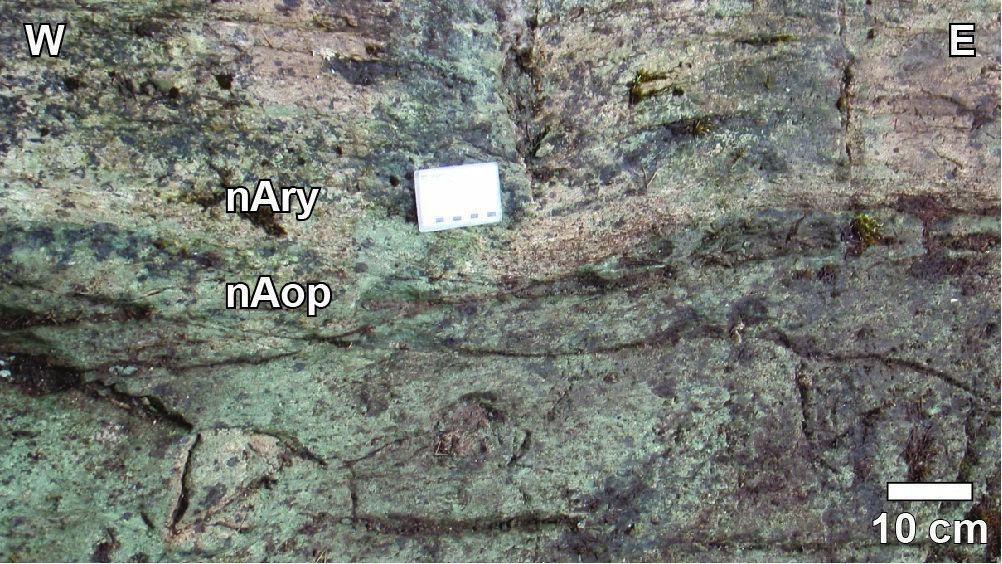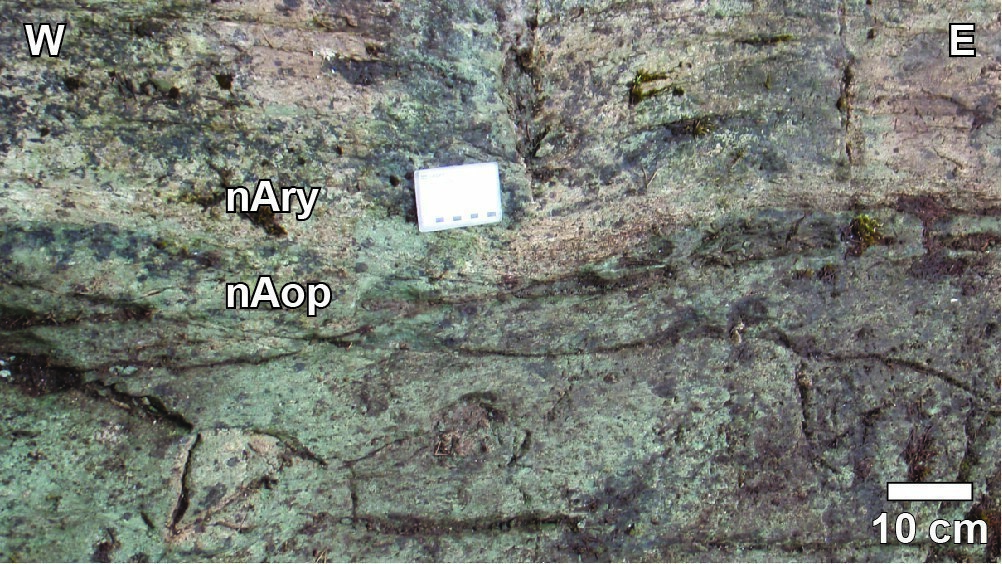
Last modified: 25 July 2018
Translation of original French
| Author: | Duquette, 1970 |
| Age: | Neoarchean |
| Reference section: | None |
| Type area: | Outcrops along Road 167 north of Lac Chibougamau (sheets 32G16-200-201 and 32G16-200-0202) define a section through the Roy Group’s two volcanic cycles |
| Geological province: | Superior Province |
| Geological subdivision: | Abitibi Subprovince |
| Lithology: | Volcanic and sedimentary rocks |
| Type: | Lithostratigraphic |
| Rank: | Group |
| Status: | Formal |
| Use: | Active |
- Roy Group
- Bordeleau Formation
- Ruisseau Dalime Formation
- Scorpion Formation
- Phooey Member
- Blondeau Formation
- Bruneau Formation
- Waconichi Formation
- Allard Member
- Scott Member
- Deux Orignaux Member
- Winchester Member
- Lemoine Member
- Portage Member
- Lacs Member
- Îles Member
- Coyote Member
- Chevrier Member
- Queylus Member
- Andy Member
- Obatogamau Formation
- Pichamobi Member
- Wachigabau Member
- David Member
Background
The Roy Group is first mentioned in Duquette’s report (1970) on the “Archean stratigraphy and metallogenic relations in the Chibougamau region”. It includes volcano-sedimentary assemblages identified in previous geological reports as “Keewatinian-type rocks”.
Description
The Roy Group consists of two volcanic cycles (Duquette,1970; Allard, 1976; Allard et al., 1979; Daigneault and Allard, 1990; Leclerc et al., 2011): the first cycle comprises the Obatogamau and Waconichi formations (2730-2726 Ma; Mortensen, 1993; Legault, 2003; Leclerc et al., 2011), while the second cycle is composed of the Bruneau, Blondeau, Scorpion and Bordeleau formations (2724-2716 Ma; Leclerc et al., 2012; David et al., 2012; Davis et al., 2014). At the base of the volcanic cycles, mafic volcanic rocks have a tholeiitic affinity and change upwards to volcaniclastic and metasedimentary rocks of transitional to calc-alkaline affinity (Daigneault and Allard, 1990; Roy et al., 2007; Leclerc et al., 2011).
Thickness and Distribution
The Roy Group has a total thickness evaluated between 10 000 m and 12 000 m. It is recognized from the Grenville Front Tectonic Zone in the east to the Desmaraisville area in the west. The Roy Group is limited to the north by foliated to gneissic intrusive units of the Opatica Subprovince and extends to the southern limit of the Caopatina-Guercheville Deformation Corridor.
Dating
Rocks of the Obatogamau Formation, at the base of the Roy Group, are older than those of the Waconichi Formation, whose ages range from 2729.7 +1.9/1.6 Ma to 2726.6 ±0.7 Ma (Mortensen, 1993; Legault, 2003; Leclerc et al., 2011; David et al., 2012). However, they are younger than those of the Chrissie Formation (2791.4 +3.7/-2.9 Ma; David et al., 2011). At the top of the Roy Group, felsic volcanic rocks of the Scorpion Formation are dated 2716.4 ±1.0 Ma (David et al., 2012).
Stratigraphic Relationship(s)
At the base of the Roy Group, the contact of the Obatogamau Formation’s mafic volcanic rocks corresponds to shear zones observed in the field or interpreted using aeromagnetic data. These shear zones mark a hiatus of 60 Ma to 100 Ma between mafic volcanic rocks of the Obatogamo Formation (older than the overlying rocks of the Waconichi Formation) and the much younger rocks of the underlying Isostao Gneissic Complex (2831 ±5 Ma; Roffeis, 2015), Vents Formation (2798.7 ±0.7 Ma; Davis et al., 2014), and Chrissie Formation (2791.4 +3.7/-2.9 Ma; David et al., 2011). At the top of the Roy Group, the contact is generally characterized by an angular discordance with sedimentary rocks of the Opemisca Group (Cimon, 1976; Caty, 1978; Simoneau, 1986). However, sedimentary rocks of the Bordeleau Formation in the Waconichi Syncline are locally a transitional unit between the two groups (Caty, 1979; Dimroth et al., 1983).
Paleontology
Does not apply.
References
| Author(s) | Title | Year of Publication | Hyperlink (EXAMINE or Other) |
|---|---|---|---|
| ALLARD, G.O. | Doré Lake Complex and its importance to Chibougamau geology and metallogeny. Ministère des Richesses naturelles, Québec; DPV 368, 446 pages, 2 plans. | 1976 | DPV 368 |
| ALLARD, G.O. – CATY, J.L. – CHOWN, E.H. – CIMON, J. – GOBEIL, A. – BAKER, D. | Stratigraphie et métallogénie de la région de Chibougamau. Mineralogical Association of Canada; Fieldtrip guide B-1, 62 pages. | 1979 | – |
| CATY, J.L. | Canton de Richardson (comté d’Abitibi-Est) – Rapport interimaire. Ministère des Richesses naturelles, Québec; DP-606, 37 pages, 1 plan. | 1978 | DP 606 |
| CATY, J.L. | Demie-ouest du canton de Bignell. Ministère de l’Énergie et des Ressources, Québec; DPV-678, 22 pages, 1 plan. | 1979 | DPV 678 |
| CIMON, J. | Géologie du canton de Queylus (NE), Abitibi-Est. Ministère des Richesses naturelles du Québec; DPV 439, 38 pages, 1 plan. | 1976 | DPV 439 |
| DAVID, J. – VAILLANCOURT, D. – BANDYAYERA, D. – SIMARD, M. – GOUTIER, J. – PILOTE, P. – DION, C. – BARBE, P. | Datations U-Pb effectuées dans les sous-provinces d’Ashuanipi, de La Grande, d’Opinaca et d’Abitibi en 2008-2009. Ministère des Ressources naturelles et de la Faune, Québec; RP 2010-11, 37 pages. | 2011 | RP 2010-11 |
| DAVID, J. – SIMARD, M. – BANDYAYERA, D. – GOUTIER, J. – HAMMOUCHE, H. – PILOTE, P. – LECLERC, F. – DION, C. | Datations U-Pb effectuées dans les provinces du Supérieur et de Churchill en 2010-2011. Ministère des Ressouces naturelles et de la Faune, Québec; RP 2012-01, 33 pages. | 2012 | RP 2012-01 |
| DAVIS, D.W. – SIMARD, M. – HAMMOUCHE, H. –BANDYAYERA, D. – GOUTIER, J. – PILOTE, P. – LECLERC, F. – DION, C. | Datations U-Pb effectuées dans les provinces du Supérieur et de Churchill en 2011-2012. Ministère des Ressources naturelles, Québec; RP 2014-05, 62 pages. | 2014 | RP 2014-05 |
| DAIGNEAULT, R. – ALLARD, G.O. | Le Complexe du Lac Doré et son environnement géologique. Ministère de l’Énergie et des Ressources, Québec; MM 89-03, 375 pages. | 1990 | MM 89-03 |
| DIMROTH, E. – MUELLER, W. – ROCHELEAU, M. – ARCHER, P. – JUTRAS, M. – PICHÉ, M. – SIMONEAU, P. – CARIGNAN, J. – CHOWN, E.H. – GUHA, J. – GOULET, N. – ALLARD, G.O. – FRANCONI, A. – GOBEIL, A. | Stratigraphie et évolution du bassin de transition entre les groupes de Roy et d’Opémisca, région de Chibougamau-Chapais. Dans : Stratigraphie des ensembles volcano-sédimentaires archéens de l’Abitibi : état des connaissances. Ministère de l’Énergie et des Ressources, Québec; DV 83-11, pages 21-33. | 1983 | DV 83-11 |
| DUQUETTE, G. | Stratigraphie de l’Archéen et relations métallogéniques dans la région de Chibougamau. Ministère des Richesses naturelles, Québec; ES-008, 25 pages, 1 plan. | 1970 | ES 008 |
| LECLERC, F. – BÉDARD, J.H. – HARRIS, L.B. – McNICOLL, V. – GOULET, N. – ROY, P. – HOULE, P. | Tholeiitic to calc-alkaline cyclic volcanism in the Roy Group, Chibougamau area, Abitibi Greenstone Belt – Revised stratigraphy and implications for VHMS exploration. Canadian Journal of Earth Sciences; volume 48, pages 661-694. | 2011 | Source |
| LECLERC, F. – HARRIS, L.B. – BÉDARD, J.H. – VAN BREEMEN, O. – GOULET, N. | Structural and stratigraphic controls on magmatic, volcanogenic and syn-tectonic mineralization in the Chapais-Chibougamau mining camp, northeastern Abitibi, Canada. Economic Geology; volume 107, pages 963-989. | 2012 | Source |
| LEGAULT, M. | Environnement métallogénique du couloir de Fancamp avec emphase sur les gisements aurifères de Chevrier, région de Chibougamau, Québec. Université du Québec à Chiboutimi; doctoral thesis, 488 pages. | 2003 | Source |
| MORTENSEN, J.K. | U-Pb geochronology of the eastern Abitibi subprovince. Part 1 : Chibougamau – Matagami – Joutel region. Canadian Journal of Earth Sciences; volume 30, pages 11-28. | 1993 | Source |
| ROY P. – FALLARA, F. – HOULE, P. – CHENG, L.Z. – RABEAU, O. – BLAIS, A. – LAFRANCE, B. – LECLERC, F. – PILOTE, P. – RIVERIN, G. – SCHMITT, L. |
Étude sur le flanc sud du Complexe du Lac Doré, Chibougamau: stratigraphie, veines Cu-Au et modèle 3D préliminaire. Dans: Québec Exploration 2007, Abstracts of talks and posters. Ministère des Ressources naturelles et de la Faune, Québec; DV 2007-04, page 37. |
2007 | DV 2007-04 |
| ROFFEIS, C. | Rapport final du contrat de géochronologie MERN. Ministère de l’Énergie et des Ressources naturelles, Québec; unpublished internal report, 16 pages. | 2015 | – |
| SIMONEAU, P. | Pétrologie, sédimentologie et analyse des faciès de la Formation de Daubrée, Chapais, Québec. Université du Québec à Chicoutimi; Masters thesis, 486 pages, 1 plan. | 1986 | Source |


